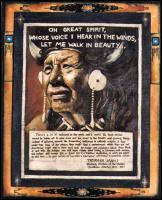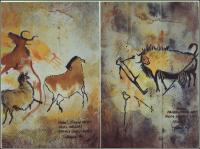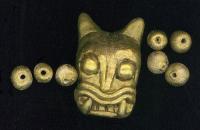The Influence of History
 I won’t pretend to know a lot about cultures, but I do know what I like…their Art!
I won’t pretend to know a lot about cultures, but I do know what I like…their Art!
Regardless of time or territory, our way of life is represented by the objects we make. Civilizations thrive and vanish, and history is documented by discoveries of the everyday objects they left behind. Millions of tourists are drawn annually to visit ancient places like Asian temples, the Egyptian pyramids, the Anasazi Cliff Dwellings, Machu Picchu. Even if the adventure is only experienced through photographs, these are enough to transport the imagination to where real people lived some pretty astonishing lives.
 I have wondered what compelled the first person to take charcoal from the fire and mark a cave wall, and try to imagine the first time someone used clay fom the earth to form a container. What brought a hunter to embellish a spear, believing it would bring luck and protection during the hunt? With the first manipulating of materials at hand into tools and useful objects, early humans had a keen awareness of their surroundings, an increasing consciousness of all life, and questions about the frightening unknown in the context of a daily struggle for survival. This was the dawning of creativity. Myths, legends and customs arose from the need to explain unseen forces like the unpredictable violence of weather and celestial events. Song, dance, and stories about animals or creatures with human traits gave everything a purpose and a place, a sense of safety and empowerment, and kinship with the environment. Applying indigenous natural resources as materials for the decoration of bodies, clothing and costume also reflected these themes, and design became entwined with custom.
I have wondered what compelled the first person to take charcoal from the fire and mark a cave wall, and try to imagine the first time someone used clay fom the earth to form a container. What brought a hunter to embellish a spear, believing it would bring luck and protection during the hunt? With the first manipulating of materials at hand into tools and useful objects, early humans had a keen awareness of their surroundings, an increasing consciousness of all life, and questions about the frightening unknown in the context of a daily struggle for survival. This was the dawning of creativity. Myths, legends and customs arose from the need to explain unseen forces like the unpredictable violence of weather and celestial events. Song, dance, and stories about animals or creatures with human traits gave everything a purpose and a place, a sense of safety and empowerment, and kinship with the environment. Applying indigenous natural resources as materials for the decoration of bodies, clothing and costume also reflected these themes, and design became entwined with custom.
 We see the same creativity alive today; Art is still intimately connected with life as we try to understand it. Only the circumstances have changed. Where on earth we find materials doesn’t make as much difference now, because travel has changed everything, but the motivation to build and create remains much the same. We still need food and shelter, things are still designed to make life easier. We enjoy transforming the unpleasant into something more acceptable, create things that represent group and family spirit, and express our individuality. The biggest changes and differences due to our era of sophistication are in our methods and manufacturing, where a better quality of product is accessible. However, quality is often diluted or lost in exchange for quantity, and this is where the Artists’ role will always make a difference.
We see the same creativity alive today; Art is still intimately connected with life as we try to understand it. Only the circumstances have changed. Where on earth we find materials doesn’t make as much difference now, because travel has changed everything, but the motivation to build and create remains much the same. We still need food and shelter, things are still designed to make life easier. We enjoy transforming the unpleasant into something more acceptable, create things that represent group and family spirit, and express our individuality. The biggest changes and differences due to our era of sophistication are in our methods and manufacturing, where a better quality of product is accessible. However, quality is often diluted or lost in exchange for quantity, and this is where the Artists’ role will always make a difference.
We grasp for wherever proof of spirit is visible, and it’s right there, palpable in the things created long ago, and in all the things we create now.
 Whether it was primitive adornment, biblical themes popularized during Renaissance times, or Andy Warhol’s everyday objects in galleries, as far as the Artist is concerned what we call “Art” has always been about response, expression, interpretations, experiments, questions, and attempting to know what’s beyond the superficial nature of things. Progress in science,
Whether it was primitive adornment, biblical themes popularized during Renaissance times, or Andy Warhol’s everyday objects in galleries, as far as the Artist is concerned what we call “Art” has always been about response, expression, interpretations, experiments, questions, and attempting to know what’s beyond the superficial nature of things. Progress in science,  medicine, and even warfare (ironically!) have all advanced due to creative thinking. City design and engineering still rely on basic geometric principles learned and practiced thousands of years ago. Artists are the grass roots of Society’s stirrings, often the ones who come up with the ideas that entrepreneurs run with, and Art still represents the best of what society as a whole has to offer.
medicine, and even warfare (ironically!) have all advanced due to creative thinking. City design and engineering still rely on basic geometric principles learned and practiced thousands of years ago. Artists are the grass roots of Society’s stirrings, often the ones who come up with the ideas that entrepreneurs run with, and Art still represents the best of what society as a whole has to offer.
Since who knows when, Artists have had reputations as weird, rebellious, argumentative, driven, crazy, and overly sensitive. More accurately, all these personality traits go hand in hand with how we are able to do what we do.
 In order to come up with insightful, original and innovative ideas, certain abilities are required. Like two sides of the same coin, the nature of the above characteristics also involves an openness to change or reconsider all sides of a suggestion, and despite the impressions given, enough objectivity is required to be able to identify and identify with the external world. If the Art will ever become something that others can recognize or identify with, for the one creating it, this sense of identification is very much like another interpreting and translating another language. It is being objective about the subjective, and very much about extra-sensory perception.
In order to come up with insightful, original and innovative ideas, certain abilities are required. Like two sides of the same coin, the nature of the above characteristics also involves an openness to change or reconsider all sides of a suggestion, and despite the impressions given, enough objectivity is required to be able to identify and identify with the external world. If the Art will ever become something that others can recognize or identify with, for the one creating it, this sense of identification is very much like another interpreting and translating another language. It is being objective about the subjective, and very much about extra-sensory perception.
 In other words, abstract thoughts are transformed… using any variety of materials… to build, rebuild, and solidify them into another matter. Creating Art is physical and metaphysical, involving so-called “reality” as well as non-visible indescribable intuition.
In other words, abstract thoughts are transformed… using any variety of materials… to build, rebuild, and solidify them into another matter. Creating Art is physical and metaphysical, involving so-called “reality” as well as non-visible indescribable intuition.
 Creating Art is emotional and at the same time the most honest, straight-forward logical communication possible. Creativity is an alchemy of structure and “heart” that is much like mixing oil and water. Who would not appear to be on the verge of madness trying to find commonalities and a way for those two opposing forces to cooperate, and then try to communicate how they did it? Art is often described as organized chaos. Another cliche is that “Life reflects Art”, and what that really means is that creating Art involves a lifetime of organizing and transforming chaos. The point is that certain abilities and associated character traits are part and parcel to the same creative forces that encouraged the progression of societies toward the New World as we know it.
Creating Art is emotional and at the same time the most honest, straight-forward logical communication possible. Creativity is an alchemy of structure and “heart” that is much like mixing oil and water. Who would not appear to be on the verge of madness trying to find commonalities and a way for those two opposing forces to cooperate, and then try to communicate how they did it? Art is often described as organized chaos. Another cliche is that “Life reflects Art”, and what that really means is that creating Art involves a lifetime of organizing and transforming chaos. The point is that certain abilities and associated character traits are part and parcel to the same creative forces that encouraged the progression of societies toward the New World as we know it.
 From the first marks on stone, communication has its roots. The first forms of writing were pictures and recognizable symbols, some which are still used to this day. Writing can be more effective when accompanied by imagery; pictures fill gaps and speak volumes where words might fail. Symbols – graphic representations of objects or ideas – portray meaning with impact, are a mainstay on the internet now, used in design for corporate logos, and pleading to our senses through advertising.
From the first marks on stone, communication has its roots. The first forms of writing were pictures and recognizable symbols, some which are still used to this day. Writing can be more effective when accompanied by imagery; pictures fill gaps and speak volumes where words might fail. Symbols – graphic representations of objects or ideas – portray meaning with impact, are a mainstay on the internet now, used in design for corporate logos, and pleading to our senses through advertising.
Art and artifacts created thousands of years ago may look simple and unrefined to us now, but try recreating any, and you will shortly be impressed by the knowledge and skill those Artists had. Once in a while as a study exercise I enjoy recreating artifacts that I feel especially drawn to. It’s the best way to get a “behind the scenes” look at the Art, and fully appreciate what it took to create it in the first place.
A lot of information is obtainable through reading, but doing something with that information brings a whole other side toward a more complete understanding. There’s a sense of timelessness that occurs when you mimick the same sort of steps the original Artist took. An attempt to recreate a Mayan necklace of jaguar-shaped beads with new materials (polymer clay and metallic paints, above), I learned how the original goldsmith of that necklace applied mathematics to every creation. It was not just some crude piece of jewelry. There is nothing like trying something someone else does or has done, to make you truly appreciate it more.
 These short excursions recreating artifacts is also how I started noticing the similarities between all cultures; that creativity is our common bond. It’s the misunderstood link! There are resemblances in the simplified stylized designs of Inuit carvings from northern regions to some Pre-Columbian statues in Central America. African masks and baskets have curious resemblances to ones created by Haida natives of the Pacific Northwest.
These short excursions recreating artifacts is also how I started noticing the similarities between all cultures; that creativity is our common bond. It’s the misunderstood link! There are resemblances in the simplified stylized designs of Inuit carvings from northern regions to some Pre-Columbian statues in Central America. African masks and baskets have curious resemblances to ones created by Haida natives of the Pacific Northwest.
Science acknowledges the similarities between major cultures spanning continents and time, deducing  connections about our origins, and surprisingly are only recently appreciating the intelligence and ingenuity humans had thousands of years ago. It stands to reason that we could not be where we are today without the growth, change, knowledge and wisdom attained from past experience. Our usual frame of reference is the Middle Ages, then the mid nineteenth century onward, as to what has influenced modern culture most, but the influences must go much further back. My theory is that this is why words are so inadequate by themselves, because the influences of our communication today were the pictures, symbols, and body language we started developing tens of thousands of years ago.
connections about our origins, and surprisingly are only recently appreciating the intelligence and ingenuity humans had thousands of years ago. It stands to reason that we could not be where we are today without the growth, change, knowledge and wisdom attained from past experience. Our usual frame of reference is the Middle Ages, then the mid nineteenth century onward, as to what has influenced modern culture most, but the influences must go much further back. My theory is that this is why words are so inadequate by themselves, because the influences of our communication today were the pictures, symbols, and body language we started developing tens of thousands of years ago.
When natives from Africa to North America passed down stories thousands of years ago that the first human was molded from clay, they understood and meant that everything on earth is made of the same basic elements, and that when death occurs we all return to those elements… which is true, so it’s not a myth at all, just a creative way to teach an evolving human brain! Imagination, inventiveness and determination are the keys to our past, present and future, and it shouldn’t be surprising that we knew so many things long ago because that’s where we came from, and who we are. 
I don’t think the Artists that lived throughout history were all that different than ones alive today. We all read life and express it, share it, and pass it on. Artists feel a strong sense of duty to find and use our utmost potential. Our work stays alive long after we’re gone and influences others. Whether it stays within the family or makes a mark on humanity’s history is not too important because all of us have creative capacities, and I feel confident in saying that we all make a difference somehow.
 Life is made pleasant for all by way of the power of creativity, which is not limited to a chosen few.
Life is made pleasant for all by way of the power of creativity, which is not limited to a chosen few.
Creativity manifests in an infinite variety of ways, even seen through how much care you take mowing the lawn! It’s more likely that creativity is a genetically Human trait, not only handed down by Great-Great Grandfather… my guess is that the drive goes back much much further, to the dawning of our intelligence. However inherited or obtained, that creative potential still requires attention and development, and effort makes the difference in success, not the gift alone.
______________________________________________________________
List started of book sources and interesting reading (alphabetically):
Canadian Art From its Beginnings – Anne Newlands, 2000 Firefly Books Ltd. ISBN I-55209-450-2
Eskimo Art – Cotties Burland, The Hamlin Publishing Group Ltd., 1973 ISBN 0-600-33083-4
Great Civilizations Macropeadia – Dempsey Parr, 1999 ISBN 1-84084-444-2
Jaguar and Serpent The Cosmos of the Indians in Mexico, Central and South America– Claus Deimel and Elke Ruhnau ISBN 3-496-027002-2
Maya Divine Kings of the Rainforest – edited by Nicolai Grube ISBN 3-8290-4150-0 (highly recommended!)
Native American Art and Folklore, A Cultural Celebration – David Campbell, 1998 Brompton Books Corporation ISBN 0-517-06975-8
Principles of Decorative Design – Christopher Dresser, 1973 Acadamy Editions SBN 85670 062-2
The Bhagavad Gita – translated for the modern reader by Eknath Easwaran, 1985 5th printing 1990 ISBN 0-915132-36-2 Order this and other books by this Author directly: Nilgiri Press, Box 256, Tomales, California 94971
The Encyclopedia of North American Indian Tribes – Bill Yenne 1986 Bison Books Ltd. ISBN 0-86124-271-8
The Encyclopedia of Signs and Symbols – John Laing and David Wire, 1993 Crescent Books ISBN 0-517-07696-9
The Four Corners Timeless Lands of the Southwest – Kathleen Bryant, 2003 Northland Publishing ISBN 0-87358-830-4
The Incredible Incas and Their Timeless Land – Loren McIntyre, 1975 Published by The National Geographic Society (no ISBN)
The Smithsonian Book of North American Indians Before the coming of the Europeans – Philip Kopper, Smithsonian Books ISBN 0-89599-018-0, ISBN 0-8109-1510-3 (Abrams)
The Zen of Seeing, Drawing as Meditation – Drawn and hand-written by Frederick Franck, 1973 Random House Inc. New York
Through Indian Eyes The Untold Story of Native American People, Reader’s Digest Association Inc. ISBN 0-89577-819-6


